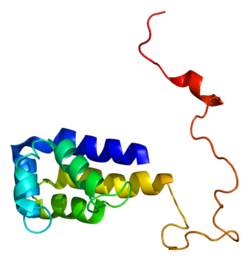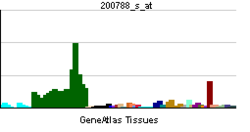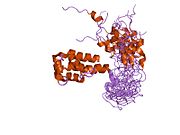- PEA15
-
Phosphoprotein enriched in astrocytes 15 
PDB rendering based on 1n3k.Available structures PDB 1n3k Identifiers Symbols PEA15; HMAT1; HUMMAT1H; MAT1; MAT1H; PEA-15; PED External IDs OMIM: 603434 MGI: 104799 HomoloGene: 7884 GeneCards: PEA15 Gene Gene Ontology Molecular function • protein binding Cellular component • cytoplasm
• microtubule associated complexBiological process • transport
• anti-apoptosis
• carbohydrate transport
• regulation of apoptosis
• response to morphine
• negative regulation of glucose importSources: Amigo / QuickGO RNA expression pattern 

More reference expression data Orthologs Species Human Mouse Entrez 8682 18611 Ensembl ENSG00000162734 ENSMUSG00000013698 UniProt Q15121 Q62048 RefSeq (mRNA) NM_003768 NM_011063.2 RefSeq (protein) NP_003759 NP_035193.1 Location (UCSC) Chr 1:
160.18 – 160.19 MbChr 1:
174.13 – 174.14 MbPubMed search [1] [2] Astrocytic phosphoprotein PEA-15 is a protein that in humans is encoded by the PEA15 gene.[1][2]
PEA15 is a death effector domain (DED)-containing protein predominantly expressed in the central nervous system, particularly in astrocytes.[2]
PEA-15 promotes autophagy in glioma cells in a JNK-dependent manner.[3]
Interactions
PEA15 has been shown to interact with Phospholipase D1,[4] Caspase 8,[5][6] MAPK1,[7] FADD[5][6] and RPS6KA3.[8]
References
- ^ Hwang S, Kuo WL, Cochran JF, Guzman RC, Tsukamoto T, Bandyopadhyay G, Myambo K, Collins CC (Sep 1997). "Assignment of HMAT1, the human homolog of the murine mammary transforming gene (MAT1) associated with tumorigenesis, to 1q21.1, a region frequently gained in human breast cancers". Genomics 42 (3): 540–2. doi:10.1006/geno.1997.4768. PMID 9205133.
- ^ a b "Entrez Gene: PEA15 phosphoprotein enriched in astrocytes 15". http://www.ncbi.nlm.nih.gov/sites/entrez?Db=gene&Cmd=ShowDetailView&TermToSearch=8682.
- ^ Böck BC, Tagscherer KE, Fassl A, et al. (July 2010). "The PEA-15 protein regulates autophagy via activation of JNK". J. Biol. Chem. 285 (28): 21644–54. doi:10.1074/jbc.M109.096628. PMC 2898427. PMID 20452983. http://www.jbc.org/cgi/pmidlookup?view=long&pmid=20452983.
- ^ Zhang, Y; Redina O, Altshuller Y M, Yamazaki M, Ramos J, Chneiweiss H, Kanaho Y, Frohman M A (Nov. 2000). "Regulation of expression of phospholipase D1 and D2 by PEA-15, a novel protein that interacts with them". J. Biol. Chem. (UNITED STATES) 275 (45): 35224–32. doi:10.1074/jbc.M003329200. ISSN 0021-9258. PMID 10926929.
- ^ a b Kitsberg, D; Formstecher E, Fauquet M, Kubes M, Cordier J, Canton B, Pan G, Rolli M, Glowinski J, Chneiweiss H (Oct. 1999). "Knock-out of the neural death effector domain protein PEA-15 demonstrates that its expression protects astrocytes from TNFalpha-induced apoptosis". J. Neurosci. (UNITED STATES) 19 (19): 8244–51. PMID 10493725.
- ^ a b Condorelli, G; Vigliotta G, Cafieri A, Trencia A, Andalò P, Oriente F, Miele C, Caruso M, Formisano P, Beguinot F (Aug. 1999). "PED/PEA-15: an anti-apoptotic molecule that regulates FAS/TNFR1-induced apoptosis". Oncogene (ENGLAND) 18 (31): 4409–15. doi:10.1038/sj.onc.1202831. ISSN 0950-9232. PMID 10442631.
- ^ Formstecher, E; Ramos J W, Fauquet M, Calderwood D A, Hsieh J C, Canton B, Nguyen X T, Barnier J V, Camonis J, Ginsberg M H, Chneiweiss H (Aug. 2001). "PEA-15 mediates cytoplasmic sequestration of ERK MAP kinase". Dev. Cell (United States) 1 (2): 239–50. doi:10.1016/S1534-5807(01)00035-1. ISSN 1534-5807. PMID 11702783.
- ^ Vaidyanathan, Hema; Ramos Joe W (Aug. 2003). "RSK2 activity is regulated by its interaction with PEA-15". J. Biol. Chem. (United States) 278 (34): 32367–72. doi:10.1074/jbc.M303988200. ISSN 0021-9258. PMID 12796492.
Further reading
- Araujo H, Danziger N, Cordier J, et al. (1993). "Characterization of PEA-15, a major substrate for protein kinase C in astrocytes". J. Biol. Chem. 268 (8): 5911–20. PMID 8449955.
- Estellés A, Yokoyama M, Nothias F, et al. (1996). "The major astrocytic phosphoprotein PEA-15 is encoded by two mRNAs conserved on their full length in mouse and human". J. Biol. Chem. 271 (25): 14800–6. doi:10.1074/jbc.271.25.14800. PMID 8662970.
- Condorelli G, Vigliotta G, Iavarone C, et al. (1998). "PED/PEA-15 gene controls glucose transport and is overexpressed in type 2 diabetes mellitus". EMBO J. 17 (14): 3858–66. doi:10.1093/emboj/17.14.3858. PMC 1170721. PMID 9670003. http://www.pubmedcentral.nih.gov/articlerender.fcgi?tool=pmcentrez&artid=1170721.
- Kubes M, Cordier J, Glowinski J, et al. (1998). "Endothelin induces a calcium-dependent phosphorylation of PEA-15 in intact astrocytes: identification of Ser104 and Ser116 phosphorylated, respectively, by protein kinase C and calcium/calmodulin kinase II in vitro". J. Neurochem. 71 (3): 1307–14. doi:10.1046/j.1471-4159.1998.71031307.x. PMID 9721757.
- Condorelli G, Vigliotta G, Cafieri A, et al. (1999). "PED/PEA-15: an anti-apoptotic molecule that regulates FAS/TNFR1-induced apoptosis". Oncogene 18 (31): 4409–15. doi:10.1038/sj.onc.1202831. PMID 10442631.
- Kitsberg D, Formstecher E, Fauquet M, et al. (1999). "Knock-out of the neural death effector domain protein PEA-15 demonstrates that its expression protects astrocytes from TNFalpha-induced apoptosis". J. Neurosci. 19 (19): 8244–51. PMID 10493725.
- Wolford JK, Bogardus C, Ossowski V, Prochazka M (2000). "Molecular characterization of the human PEA15 gene on 1q21-q22 and association with type 2 diabetes mellitus in Pima Indians". Gene 241 (1): 143–8. doi:10.1016/S0378-1119(99)00455-2. PMID 10607908.
- Zhang Y, Redina O, Altshuller YM, et al. (2001). "Regulation of expression of phospholipase D1 and D2 by PEA-15, a novel protein that interacts with them". J. Biol. Chem. 275 (45): 35224–32. doi:10.1074/jbc.M003329200. PMID 10926929.
- Formstecher E, Ramos JW, Fauquet M, et al. (2001). "PEA-15 mediates cytoplasmic sequestration of ERK MAP kinase". Dev. Cell 1 (2): 239–50. doi:10.1016/S1534-5807(01)00035-1. PMID 11702783.
- Condorelli G, Trencia A, Vigliotta G, et al. (2002). "Multiple members of the mitogen-activated protein kinase family are necessary for PED/PEA-15 anti-apoptotic function". J. Biol. Chem. 277 (13): 11013–8. doi:10.1074/jbc.M110934200. PMID 11790785.
- Xiao C, Yang BF, Asadi N, et al. (2002). "Tumor necrosis factor-related apoptosis-inducing ligand-induced death-inducing signaling complex and its modulation by c-FLIP and PED/PEA-15 in glioma cells". J. Biol. Chem. 277 (28): 25020–5. doi:10.1074/jbc.M202946200. PMID 11976344.
- Strausberg RL, Feingold EA, Grouse LH, et al. (2003). "Generation and initial analysis of more than 15,000 full-length human and mouse cDNA sequences". Proc. Natl. Acad. Sci. U.S.A. 99 (26): 16899–903. doi:10.1073/pnas.242603899. PMC 139241. PMID 12477932. http://www.pubmedcentral.nih.gov/articlerender.fcgi?tool=pmcentrez&artid=139241.
- Vaidyanathan H, Ramos JW (2003). "RSK2 activity is regulated by its interaction with PEA-15". J. Biol. Chem. 278 (34): 32367–72. doi:10.1074/jbc.M303988200. PMID 12796492.
- Trencia A, Perfetti A, Cassese A, et al. (2003). "Protein kinase B/Akt binds and phosphorylates PED/PEA-15, stabilizing its antiapoptotic action". Mol. Cell. Biol. 23 (13): 4511–21. doi:10.1128/MCB.23.13.4511-4521.2003. PMC 164852. PMID 12808093. http://www.pubmedcentral.nih.gov/articlerender.fcgi?tool=pmcentrez&artid=164852.
- Ota T, Suzuki Y, Nishikawa T, et al. (2004). "Complete sequencing and characterization of 21,243 full-length human cDNAs". Nat. Genet. 36 (1): 40–5. doi:10.1038/ng1285. PMID 14702039.
- Trencia A, Fiory F, Maitan MA, et al. (2004). "Omi/HtrA2 promotes cell death by binding and degrading the anti-apoptotic protein ped/pea-15". J. Biol. Chem. 279 (45): 46566–72. doi:10.1074/jbc.M406317200. PMID 15328349.
- Gaumont-Leclerc MF, Mukhopadhyay UK, Goumard S, Ferbeyre G (2004). "PEA-15 is inhibited by adenovirus E1A and plays a role in ERK nuclear export and Ras-induced senescence". J. Biol. Chem. 279 (45): 46802–9. doi:10.1074/jbc.M403893200. PMID 15331596.
- Gerhard DS, Wagner L, Feingold EA, et al. (2004). "The status, quality, and expansion of the NIH full-length cDNA project: the Mammalian Gene Collection (MGC)". Genome Res. 14 (10B): 2121–7. doi:10.1101/gr.2596504. PMC 528928. PMID 15489334. http://www.pubmedcentral.nih.gov/articlerender.fcgi?tool=pmcentrez&artid=528928.
- Renganathan H, Vaidyanathan H, Knapinska A, Ramos JW (2006). "Phosphorylation of PEA-15 switches its binding specificity from ERK/MAPK to FADD". Biochem. J. 390 (Pt 3): 729–35. doi:10.1042/BJ20050378. PMC 1199667. PMID 15916534. http://www.pubmedcentral.nih.gov/articlerender.fcgi?tool=pmcentrez&artid=1199667.
PDB gallery Categories:- Human proteins
- Chromosome 1 gene stubs
Wikimedia Foundation. 2010.

